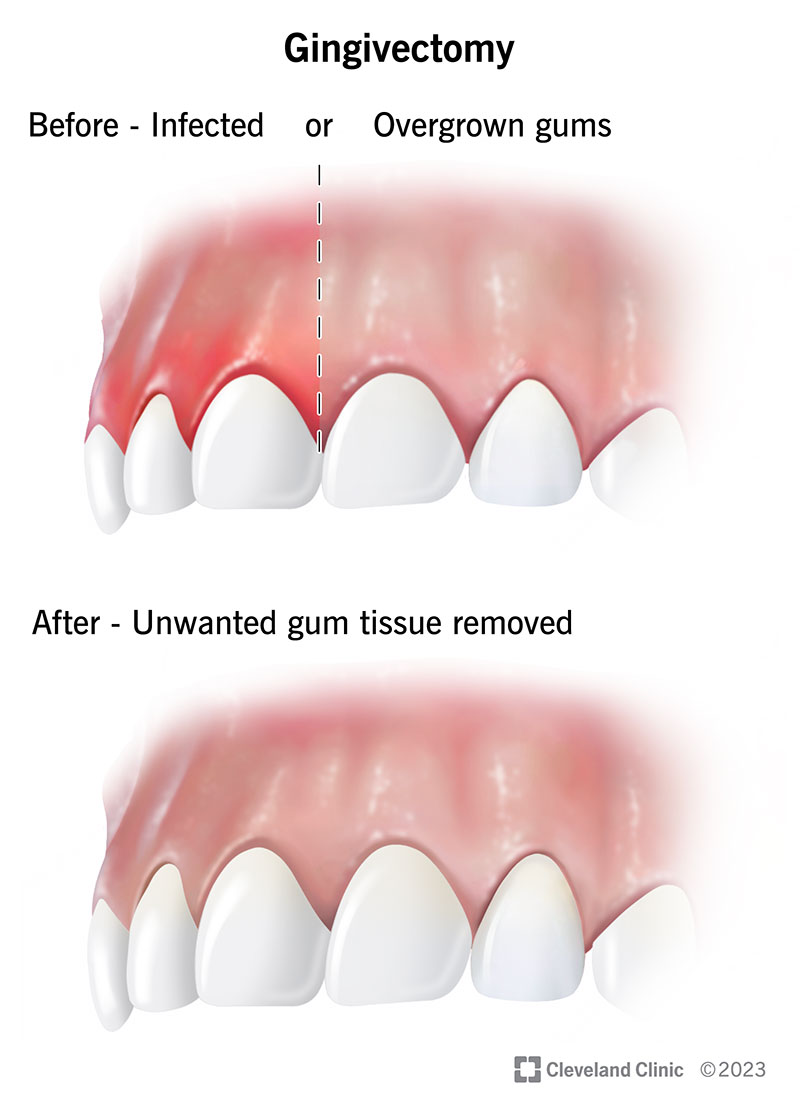Gingivectomy is the surgical removal of gum tissue. Periodontists use gingivectomy to treat some forms of gum disease. It’s also a common cosmetic surgery used to improve the appearance of your smile. It takes about a week to recover after gingivectomy, and the results are usually permanent.
Advertisement
Cleveland Clinic is a non-profit academic medical center. Advertising on our site helps support our mission. We do not endorse non-Cleveland Clinic products or services. Policy

Gingivectomy is surgery to remove excess or overgrown gum tissue (gingiva). Periodontists (gum specialists) use gingivectomy to treat some forms of periodontal (gum) disease. Gingivectomy is also a common cosmetic dentistry procedure used to fix a “gummy smile” (when excess gum tissue makes your teeth look short or “boxy”).
Advertisement
Cleveland Clinic is a non-profit academic medical center. Advertising on our site helps support our mission. We do not endorse non-Cleveland Clinic products or services. Policy
There are two main types of gingivectomy:
A gingivectomy procedure may be right for you if you have:
Certain medications can result in excess gum tissue, too. Examples include amlodipine for high blood pressure or cyclosporine as an immunosuppressant. If you develop puffy, overgrown gums after starting a particular medication, be sure to tell your healthcare provider. They may be able to switch medications or change your dosage.
Before your gingivectomy, your periodontist will talk with you about what to expect. You usually don’t need to do anything else to prepare.
Advertisement
However, if you opt for sedation dentistry, be sure you bring a trusted friend or family member to drive you to and from your appointment.
Here are the steps you can expect during a gingivectomy procedure:
In most cases, it takes between 30 and 60 minutes to complete a gingivectomy procedure. If you need gingivectomy on several teeth, it may take a little longer.
Gingivectomy is an outpatient procedure, so you’ll be able to go home the same day. Your surgeon will give you a list of post-operative instructions to keep you comfortable during recovery at home.
Gingivectomy offers a number of benefits. The procedure:
Like all surgical procedures, you can expect some side effects following gingivectomy, including:
The side effects listed above are normal and should fade within three to four days.
Rarely, people may develop complications such as:
On average, it takes about one week for your gums to heal following gingivectomy.
After gingivectomy, your surgeon will give you a list of detailed post-operative instructions. You should follow these guidelines closely. Here are some basic recommendations for gingivectomy aftercare:
Advertisement
Most people can return to work or school in a day or two. But keep activity light. If your job requires a lot of physical labor, you may want to stay home for at least three days.
Be sure you avoid strenuous exercise or heavy lifting for at least 48 hours. An elevated heart rate could cause more pain, bleeding and swelling.
Advertisement
Yes, you can eat after a gingivectomy procedure. But to avoid discomfort, you should wait until the numbness from the anesthesia wears off.
Start with liquids or soft foods. After a few days, introduce more solid foods as your comfort level allows.
Call your surgeon right away if you’ve recently had a gingivectomy and develop:
Gingivoplasty and crown lengthening share some similarities with gingivectomy. But these three procedures have different purposes:
These are all periodontal procedures, but they’re slightly different:
Periodontists may perform these as standalone treatments or in combination with one another, depending on your unique needs.
You can expect to have some degree of discomfort following gingivectomy. You can manage pain and other side effects with over-the-counter pain relievers.
Advertisement
If you’ve taken your medication as directed and you’re still having pain, call your surgeon.
The vast majority of people with braces don’t need gingivectomy. However, some people develop swollen and puffy gums after they get braces. Most of the time, you can prevent this with improved brushing and flossing at home. But some people may require gingivectomy. Your orthodontist can tell you if gingivectomy would be beneficial for you.
No, gingivectomy results are permanent when a skilled surgeon performs the procedure.
Gingivectomy is the surgical removal of gum tissue. People with gingivitis or periodontitis may need gingivectomy to reduce bacteria and improve oral health. Many people also choose gingivectomy to improve the appearance of a “gummy smile.” Talk to your dentist or periodontist to learn more about gingivectomy and find out if this procedure is right for you.
Dentistry plays an important role in oral health. Cleveland Clinic’s experts can design a personalized plan that will keep you smiling for the long haul.

Last reviewed on 02/20/2023.
Learn more about the Health Library and our editorial process.